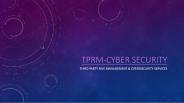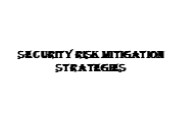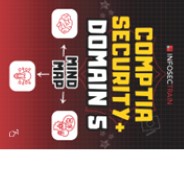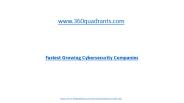Cybersecurity Risk Management And Assessment PowerPoint PPT Presentations
All Time
Recommended
Managing cyber risk is critical to any business or operation. The process of managing risks starts with a great risk assessment. MAX Cybersecurity uses an approach for larger enterprises that is built on a set of risk management principles.
| PowerPoint PPT presentation | free to download
Managing cyber risk is critical to any business or operation. The process of managing risks starts with a great risk assessment. MAX Cybersecurity uses an approach for larger enterprises that is built on a set of risk management principles.
| PowerPoint PPT presentation | free to download
Cybersecurity Risk Management is an important part of IT security. At FnCyber, we provide you with the necessary cybersecurity consulting services.
| PowerPoint PPT presentation | free to download
Cybersecurity risk management is an uphill task that does not fall under the sole purview of the IT security cell, it requires the combined efforts of an entire organization.
| PowerPoint PPT presentation | free to download
Cybersecurity Risk Management is an important part of IT security. At FnCyber, we provide you with the necessary cybersecurity consulting services.
| PowerPoint PPT presentation | free to download
Businesses today operate in an increasingly complex regulatory environment. Staying compliant with laws and regulations is not just about avoiding penalties—it is essential for building trust, ensuring business continuity, and maintaining operational efficiency. Compliance and Risk Management have become critical areas of focus for organizations that want to safeguard their reputation and minimize potential liabilities. However, businesses often struggle with fragmented compliance processes, frequent regulatory changes, and the challenge of tracking multiple obligations across jurisdictions. Without a structured framework, companies expose themselves to financial losses, operational disruptions, and legal consequences.
| PowerPoint PPT presentation | free to download
The Data Risk Management Framework by Tejasvi Addagada emphasizes the critical need for organizations to address data risks comprehensively by integrating robust governance, privacy measures, and strategic planning. Addagada’s framework is designed to formalize the management of data risks, ensuring alignment with global regulations like GDPR, BCBS, and CCAR. It highlights how enterprises can maximize data capabilities by adopting a capability-based assessment approach, which is essential for both financial and operational risk management.
| PowerPoint PPT presentation | free to download
In the realm of CRISC Domain 2, IT Risk Assessment is pivotal for effective risk management and organizational resilience. By thoroughly assessing IT risks, you ensure that your enterprise is prepared to handle potential threats while aligning with risk management objectives. Here’s why IT Risk Assessment is crucial:
| PowerPoint PPT presentation | free to download
Cybersecurity frameworks guide security strategy. Industry-specific cybersecurity standards set compliance requirements. When it comes to building a strong cybersecurity posture, it's essential to follow a robust Cybersecurity Framework and implement strong Cybersecurity Standards at the same time. Let's explore their distinctions and how they contribute to an all-inclusive security strategy.
| PowerPoint PPT presentation | free to download
Don't overlook IT & Cyber Risk Assessments! In today’s digital landscape, safeguarding your organization is non-negotiable. IT risk assessments pave the way for robust cybersecurity strategies, helping identify threats to your IT systems, data, and assets. Stay ahead in the game with strategic insights and fortify your defenses! Ready to strengthen your cyber defenses? Get in touch with us @ https://ispectratechnologies.com/blogs/strategic-insights-on-it-cyber-risk-assessments / +1 706 389 4724 today to schedule your IT risk assessment!
| PowerPoint PPT presentation | free to download
Reacting to the rising threat landscape and also complying with an increasing array of Cybersecurity, Third Party Risk Management (TPRM), and Data Privacy regulatory mandates, all while serving your operational customers, can be a daunting task.
| PowerPoint PPT presentation | free to download
Copy Link : good.readbooks.link/pw/B0C1RJ9SR1
| PowerPoint PPT presentation | free to download
SEC Cybersecurity Compliance is essential to protect sensitive financial data from cyber threats. Compliance ensures adherence to regulatory standards set by the Securities and Exchange Commission (SEC), reducing the risk of data breaches and enhancing investor confidence. It involves implementing robust security measures and regularly assessing and updating cybersecurity policies.
| PowerPoint PPT presentation | free to download
Download our comprehensive PDF on critical cybersecurity risk metrics for 2024. InfosecTrain provides actionable insights and guidelines for assessing and managing cyber risks effectively.
| PowerPoint PPT presentation | free to download
Copy Link : good.readbooks.link/pw/1119892309
| PowerPoint PPT presentation | free to download
Our steps for conducting Security Risk & Threats Assessment in Dubai and Security Audits are summarized in the following points: •Asset Characterization and Identification •Treatment /Mitigation of Risk & Vulnerability assessment •Organizational Resilience and Risk •Test, Measure, Review, Document Control, and Assurance
| PowerPoint PPT presentation | free to download
Cyber threats are increasing day by day. Adopting a risk-based cyber security strategy where you continually examine your risks is the most effective way to safeguard your organisation against cyber threats.
| PowerPoint PPT presentation | free to download
Strategic Risk Management (SRM) is a critical safeguard in the modern business toolkit. It’s not just about preventing potential pitfalls; it’s about building a framework that enables your business to bend but not break in the face of unforeseen challenges. At Ispectra Technologies, we offer a bespoke approach that prepares your business to navigate risks while pursuing success.
| PowerPoint PPT presentation | free to download
12 minutes ago - DOWNLOAD HERE : musimyangselanjutnya48.blogspot.com/?cung2=1398613495 Download Book [PDF] Cyber Risk Management: Prioritize Threats, Identify Vulnerabilities and Apply Controls | How can you manage the complex threats that can cause financial, operational and reputational damage to the business? This practical guide shows how to implement a successful cyber security programme. The second edition of Cyber Risk Management covers the latest developments in cyber security for t
| PowerPoint PPT presentation | free to download
Are you aware of your third-party vendors' risks to your business? Don't wait for disaster to strike - use ComplyAssistant's VRM framework to identify and mitigate risks in disaster recovery and cybersecurity. In this ppt, learn how our tool helps identify and assess each vendor's risk, quantify their risk level, and modify your security protocols accordingly. Get more intelligent and more secure by understanding why what you don't know can hurt you. Start using ComplyAssistant's VRM today! Learn more - https://www.complyassistant.com/resources/tips/vendor-risk-management-why-what-you-dont-know-can-hurt-you/
| PowerPoint PPT presentation | free to view
At DSP security risk assessment consultant we can benefit security costs in several ways by helping organizations identify, prioritize, and mitigate potential risks.
| PowerPoint PPT presentation | free to download
Information Security and Risk Management Training course encourages you to understand an assortment of themes in information security and risk management, for example, prologue to information security, layers of security, dangers and vulnerabilities in information security, idea of information and information security, risk displaying, risk management procedures, risk management parts, and risk evaluation strategies. Learn more about this information security and risk management training. Call us today at +1-972-665-9786. Visit our website www.tonex.com Information Security and Risk Management Training https://www.tonex.com/training-courses/information-security-and-risk-management-training/
| PowerPoint PPT presentation | free to download
let us discuss domain 2 of CISM, which is Information Risk Management.
| PowerPoint PPT presentation | free to download
Risk Management Approach to Security. Risk management is at the core of security and trust ... http://www.mi2g.com/cgi/mi2g/pdfs/drm.pdf. PROCESS ...
| PowerPoint PPT presentation | free to view
National Cybersecurity Management System Framework Maturity Model RACI Chart Impementation Guide Taieb DEBBAGH * Addressing security challenges on a global ...
| PowerPoint PPT presentation | free to download
Value Mentor is here to rescue you even before there is a security chance by giving the best Vendor Risk Assessment Company in Dubai
| PowerPoint PPT presentation | free to download
Today vendor and third party risk management software play a significant role in the success of a business. Being the most crucial part of the supply chain, most companies rely on vendor management software. Besides that, the vendor management software can also help identify cybersecurity threats before they threaten the business documents. But the fact is, many business organizations don’t know perfectly which software solution they need the most. These days, there are a plethora of options available, and they often don’t know which software goes well for their business needs. This is why, in this guide, we’ll explain to you about the vendor and third-party management software and how you can know which is suitable for you.
| PowerPoint PPT presentation | free to download
Third party risk management software vendors play a crucial role today in the business organization’s success. This is the essential part of the cybersecurity supply chain that builds a connection between the suppliers and businesses.
| PowerPoint PPT presentation | free to download
http://www.aruvio.com | Successful vendor risk management requires businesses to understand all the possible risks they face and to create a plan to address all vulnerabilities. Here is your vendor risk management checklist for small and mid-tier businesses.
| PowerPoint PPT presentation | free to download
The oil and gas industry has made a number of advances since it started its Industry 4.0 journey. Their automation and control systems, once separate from open networks, are now becoming more connected and more efficient. These advantages have come with a price, as there have also been more vulnerabilities to cyber-attacks in their network. The oil and gas industry has to adopt operational (OT) security solutions to monitor and regulate their activity in their networks, in and out of the field.
| PowerPoint PPT presentation | free to download
In today’s business world, corporations prepare to mitigate risks associated with third parties. Third party risk management tools help to manage business risks effectively. It is essential to have the Third party risk management tools to ensure operational continuity and financial survival.
| PowerPoint PPT presentation | free to download
Cyber security services & Enterprise IT risk assessment company in USA. Our EAID platform provide next generation GRC solution to strengthen your business and keep protected.
| PowerPoint PPT presentation | free to download
... ability to trust our judgement as well as the reliability and security or ... create an agent-wireless network which endowed with a proper Ontology be able to ...
| PowerPoint PPT presentation | free to view
Organizations continue to optimize their supply chains by acquiring third-party products and services that enable better performance in an increasingly competitive marketplace. Knowing who you conduct business with, what critical business processes they support, where the support is executed, how that support is delivered across your supply chain, and when that support materially changes is more than just good business practice – it is smart compliance and risk management.
| PowerPoint PPT presentation | free to download
This PDF compares and contrasts Threat Intelligence, Threat Assessment, and Threat Modelling. Understand the distinctions between these essential components of cybersecurity. Explore their roles in identifying and mitigating risks, and learn how to effectively integrate these practices into your organization's security strategy for a comprehensive threat management approach.
| PowerPoint PPT presentation | free to download
Cybersecurity Analyst (CySA+): Threat Management Summary Cybersecurity professionals are accustomed to securing access to their networks and applications. But digital transformation leads to an explosion of connected environments where perimeter protection is no longer enough. Having a solid understanding of how to tackle cybersecurity threats using a behavioral analytics-based approach is a key skill in today’s world. "Cybersecurity Analyst (CySA+): Threat Management" session will provide you with a foundational understanding of threat management practices and introduce you to the Threat Management domain of the CySA+ exam. Watch the full recorded session for free by registering here: http://bit.ly/2HHQC1C Objectives: The goals of information security Risk assessment and risk management Security zones Securing endpoints Threat Intelligence
| PowerPoint PPT presentation | free to download
Discover how becoming a Certified Authorization Professional (CAP) can elevate your cybersecurity career. This globally recognized certification validates your expertise in governance, risk management, and securing information systems, emphasizing compliance with frameworks like NIST RMF. It showcases your ability to implement effective authorization strategies and manage security risks. Earning the CAP credential not only boosts your professional credibility but also opens doors to high-demand roles in public and private sectors.
| PowerPoint PPT presentation | free to download
Security and risk management (SRM) leaders face disruptions on technological, organizational, and human fronts. Preparation and pragmatic execution are key for dealing with these disruptions and providing the right cybersecurity program.
| PowerPoint PPT presentation | free to download
Essert Inc.'s guide on SEC 10-K cybersecurity disclosures outlines new rules requiring public companies to detail their cyber risk management programs in their annual reports. These disclosures, aimed at informing shareholders, include descriptions of cyber risk programs, third-party oversight, material incidents, and governance. Companies must highlight their board's oversight and management's role in cyber risk, ensuring clarity without revealing sensitive security details. The focus is on processes rather than policies, emphasizing material risks relevant to investment decisions.
| PowerPoint PPT presentation | free to download
Global healthcare cybersecurity market size is expected to reach $42.59 billion in 2028 at a rate of 15.6%, segmented as by solution, identity and access management, risk and compliance management
| PowerPoint PPT presentation | free to download
Cybersecurity is defined as the protection of computer systems, networks, or devices from malicious attacks. The objective of cybersecurity is to protect our digital data. If any online attack strikes you, then Secninjaz Technologies LLP is here to help you to overcome this problem. There are a group of expert security professionals who help you to overcome cyber fraud and protect yourself. It provides many services like reverse engineering, security assessment, cyber fraud protection, intelligence-led penetration testing, cyber threat intelligence, cyber risk management, etc.
| PowerPoint PPT presentation | free to download
Essert Inc. offers a comprehensive platform to simplify your company's compliance with SEC cybersecurity regulations. Our tailored solutions cover every step, from risk assessment to incident response, ensuring your sensitive data remains secure and your business stays ahead of evolving threats.
| PowerPoint PPT presentation | free to download
The SEC Cybersecurity Framework mandates that public companies disclose material cybersecurity incidents within four business days. Companies must establish comprehensive cybersecurity policies, conduct regular risk assessments, and ensure robust incident response plans. The rules aim to increase transparency and accountability, protecting investors and enhancing market integrity. Non-compliance can result in legal, financial, and reputational repercussions, including enforcement actions and potential delisting from stock exchanges
| PowerPoint PPT presentation | free to download
ISO 27001 certification is crucial in today's cybersecurity landscape as it demonstrates an organization's commitment to information security management. It helps mitigate risks, protect sensitive data, ensure regulatory compliance, and build trust with clients and stakeholders. Achieving ISO 27001 enhances an organization's resilience against evolving cyber threats.
| PowerPoint PPT presentation | free to download
Security Risk Mitigation Strategies: Implement proactive measures to safeguard your assets. Identify vulnerabilities, assess risks, and develop tailored plans to mitigate potential threats. From physical security enhancements to cybersecurity measures, our strategies prioritize preemptive action, ensuring comprehensive protection for your organization's operations and assets. Trust SWC Security for expert risk management solutions.
| PowerPoint PPT presentation | free to download
Cybersecurity is indispensable when it comes to protecting digital assets like data and networks against fraudulent activities. It first emerged commercially in 1987 and today is a mainstream component of business risk management strategy. Over the years, there has been a paradigm shift in the cybersecurity landscape as it evolved from a mere concept to successfully predicting and mitigating threat vectors.
| PowerPoint PPT presentation | free to download
Essert Inc is prepared to guide clients through the latest SEC cybersecurity rules. With a focus on robust data protection measures, our expert team offers tailored solutions for compliance. From risk assessment to incident response planning, we provide comprehensive support to fortify your organization's cybersecurity posture. Partner with Essert Inc to stay ahead of regulatory changes and safeguard your digital assets effectively.
| PowerPoint PPT presentation | free to download
In ValueMentor, Security Information and Event Management (SIEM) Use Case really depends on your business risks and priorities, a detailed threat assessment is paramount in creating a comprehensive use case profile. As a result, you receive actionable alerts with lower false positives.Our cybersecurity experts will tune your SIEM, adding correlation rules and building hundreds of use cases to improve your SIEM’s performance and help you get more value and use out of your current cybersecurity posture.
| PowerPoint PPT presentation | free to download
Learn about the steps to effective vulnerability management and create a roadmap for your business's cybersecurity strategy. Improve your security posture and reduce the risk of cyber threats with this comprehensive guide.
| PowerPoint PPT presentation | free to download
Learn about the steps to effective vulnerability management and create a roadmap for your business's cybersecurity strategy. Improve your security posture and reduce the risk of cyber threats with this comprehensive guide.
| PowerPoint PPT presentation | free to download
In today's data-driven world, effective risk management hinges on leveraging both internal and external data sources. From meticulous audits and insightful user feedback to cutting-edge SIEM tools, we have the arsenal needed to combat cybersecurity threats!
| PowerPoint PPT presentation | free to download
CompTIA Security+ Domain 5: Governance, Risk, and Compliance (GRC) is a critical section of the certification that focuses on ensuring cybersecurity professionals understand the regulatory, legal, and organizational frameworks essential for maintaining robust security. This domain covers topics like risk management processes, identifying and assessing risks, implementing compliance controls, and adhering to legal requirements. It emphasizes the importance of policies, standards, and frameworks such as GDPR, HIPAA, and PCI-DSS. By mastering Domain 5, professionals can align cybersecurity practices with business objectives, effectively mitigate risks, and ensure compliance with industry regulations, making it a key area for aspiring security experts.
| PowerPoint PPT presentation | free to download
Innovative security measures, real-time detection, artificial intelligence (AI)-powered risk assessment, and more are used by these firms to defend against sophisticated cyberattacks. Let’s look at the top cybersecurity companies that will be the fastest growing in 2022.
| PowerPoint PPT presentation | free to download
After determining the Inherent Risk Profile, the credit union transitions to the Cybersecurity Maturity part of the Assessment to determine the institution ...
| PowerPoint PPT presentation | free to view
Cybersecurity is the term used for the protection of network based systems, including software, hardware and data from the cyber attacks. Global Cybersecurity Market is expected to reach USD 164 Billion by the year 2024. In a computing environment, security involves physical security and cybersecurity. Security & Vulnerability Management (SVM) is a major segment of Cybersecurity. According to Renub Research study Security and Vulnerability Assessment market will be more than USD 14.7 Billion by 2024. For More Information: https://www.renub.com/global-cybersecurity-market-nd.php
| PowerPoint PPT presentation | free to download
Delve into the realm of network security assessment service to understand its significance in safeguarding digital infrastructure. Learn about security assessment techniques and its importance for robust cybersecurity.
| PowerPoint PPT presentation | free to download












![READ How to Measure Anything in Cybersecurity Risk [PDF] PowerPoint PPT Presentation](https://s3.amazonaws.com/images.powershow.com/10109973.th0.jpg)











































